
Standard Sand Test Sieve is a standard test sieve used for particle size detection and classification of various sandstones and aggregates. It can sieve powder and granular materials within 125μm~2mm.
Price: $24.00-$26.00/PieceChat Now
Diameter: 200mm, 300mm
Height: 3.5cm, 5cm, 6cm, 7.5cm, 8cm, 10cm etc.
Aperture size: perforated plate for aperture size bigger than 1.18mm , woven mesh for aperture size smaller than 1.18mm
Specification: 0.075mm, 0.15mm, 0.6mm, 1.18mm, 2.6mm, 4.75mm, 9.5mm
Material: Brass, stainless steel, alumium, pvc coated,etc.
Weight: 0.2-0.5Kg
Port: Any port in China (Mainland)or as you need.
| Quantity(sets) | 1-2 | >2 |
| Delivery time(days) | 5 | To be negotiated |
Standard Sand Test Sieve is used to examine the particle size distribution and structural composition of sand grains. 1-8 sieve frames can be installed at a time, and the sand can be divided into 2-7 kinds of sand with different thicknesses. The materials are stainless steel, brass, and the models are 75mm, 100mm, 200mm, 300mm, 400mm, etc. optional.

Standard sand test sieve 7 sand sizes including: Gravel, Very Coarse, Coarse, Medium, Fine, Very Fine and Fine (US Standard Sieve Nos. 10, 18, 35, 60, 140 and 270).
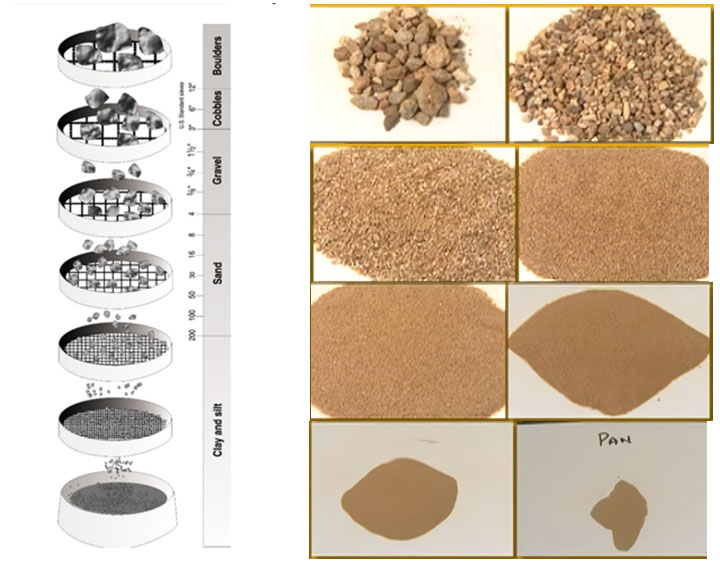
Coarse-Grained Soils: More than 50 percent retained on a 0.075 mm (No. 200) sieve
Fine-Grained Soils: 50 percent or more passes a 0.075 mm (No. 200) sieve
Gravel: Material passing a 75-mm (3-inch) sieve and retained on a 4.75-mm (No. 4) sieve.
Coarse Gravel: Material passing a 75-mm (3-inch) sieve and retained on a 19.0-mm (3/4-inch) sieve.
Fine Gravel: Material passing a 19.0-mm (3/4-inch) sieve and retained on a 4.75-mm (No. 4) sieve.
Sand: Material passing a 4.75-mm sieve (No. 4) and retained on a 0.075-mm (No. 200) sieve.
Coarse Sand: Material passing a 4.75-mm sieve (No. 4) and retained on a 2.00-mm (No. 10) sieve.
Medium Sand: Material passing a 2.00-mm sieve (No. 10) and retained on a 0.475-mm (No. 40) sieve.
Fine Sand: Material passing a 0.475-mm (No. 40) sieve and retained on a 0.075-mm (No. 200) sieve.
Clay: Material passing a 0.075-mm (No. 200) that exhibits plasticity, and strength when dry (PI ≥ 4).
Silt: Material passing a 0.075-mm (No. 200) that is non-plastic, and has little strength when dry (PI < 4).
Peat: Soil of vegetable matter.
| Sand Test Sieve Specification | ||
| Sieve Material | Brass, SS304/316/316L,galvanized,etc. | |
| Sieve Diameter | 3",6",8",10",12",200mm 300mm | |
| Frame | Material | Brass , stainless steel, alumium, pvc coated,etc. |
| Height (full) | 3.5cm,5cm, 6cm, 7.5cm, 8cm, 10cm etc. | |
| Aperture shape | Square | |
| Weave Style | plain,twill,dutch,etc. | |
| Mesh opening | 1-600mesh | |
| Aperture | 0.01-1mm | |
| Certificate | ASTM IOS SGS | |
Standard sand test sieve can be used to determine the sand composition and particle size analysis within 125μm-2mm, and can screen dry sand, fine sand, wet sand, stone sand, quartz sand, sediment, sand, sand, glass sand, soil, cement , asphalt and other materials.
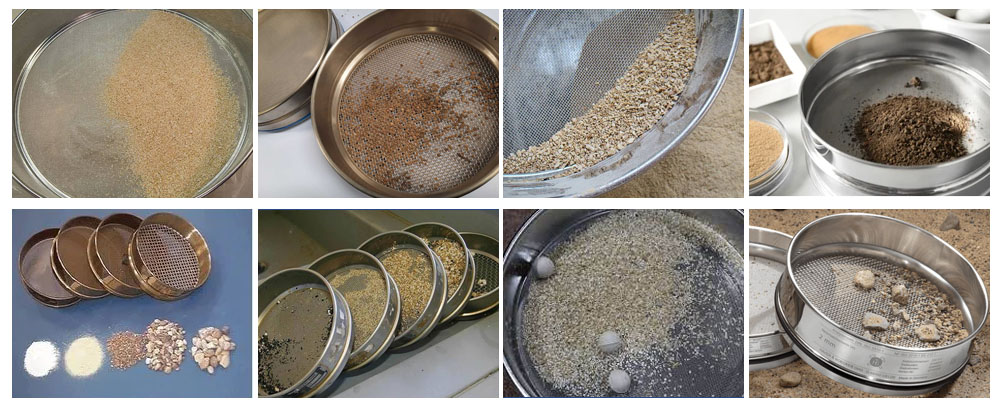
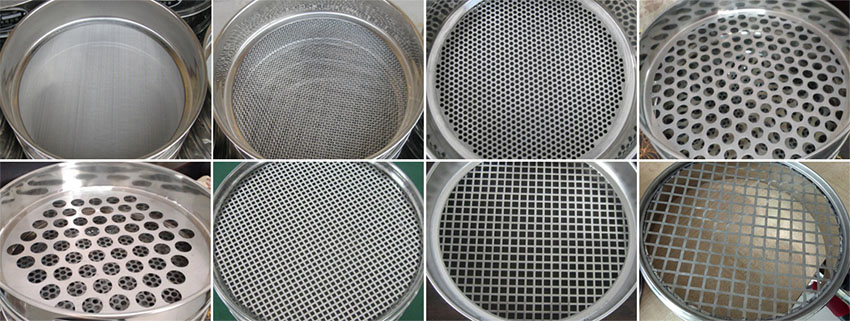
Round hole [soil sieve]: 0.075, 0.25, 0.5, 1, 2, 5, 10, 20, 40, 60mm,10pcs/set including a bottom and a cover
Square hole [stone sieve]: 2.36, 4.75, 9.5, 16, 19, 26.5, 31.5, 37.5, 53, 63, 75, 90mm,12pcs/set including a bottom and a cover
Square hole [sand sieve]: 0.075, 0.15, 0.3, 0.6, 1.18, 2.36, 4.75, 9.5mm, 8 pcs/set including a bottom and a cover
Note: Ф300mm
The round hole [stone sieve] and [sand sieve] are a set, of which there are two small sets.
Square hole [asphalt screen] (road screen): 0.075, 0.15, 0.3, 0.6, 1.18, 2.36, 4.75, 9.5, 13.2, 16, 19, 26.5, 31.5, 37.5, 53mm, 15pcs/set including a bottom and a cover.
Ф200mm [cement dry sieve]: 0.08, 0.088, 0.2, 0.9 4 pieces/set
Ф300mm [ballast sieve]: 1, 1.7, 2.5, 3.15, 5, 7.1, 10, 16, 20, 25, 35.5, 40, 45, 56, 63mm. 15pcs/set
Ф300mm【graded gravel screen】: 0.1, 0.5, 1.7, 7.1, 22.4, 31.5, 45mm,7pcs/set
【Gradation Screen】Mainly used for railways.
The sand can be divided into 2-7 different thickness specifications
It is made of SUS304 stainless steel stretched and polished, with a wall thickness of 0.6mm, uniform luster, strong and durable, and non-magnetic;
Fine sieving, can sieve sand down to 5 microns
Dry and wet can be screened, suitable for dry sand, wet sand and other types of sand testing
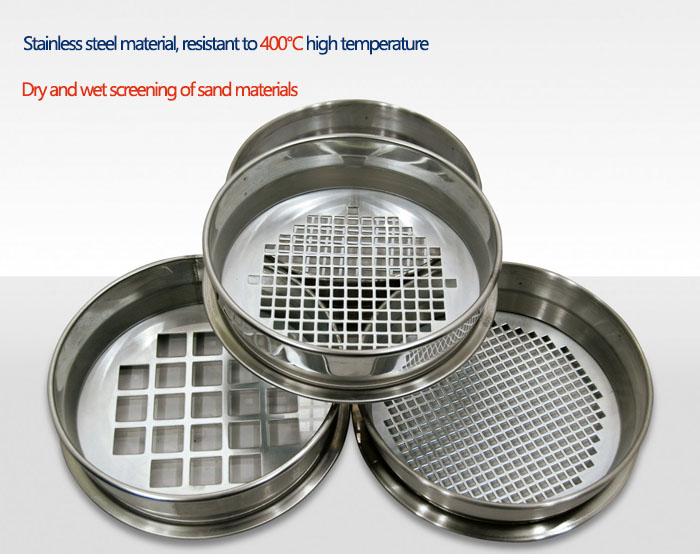
When the Standard sand test sieve is working, first put the sand material to be tested into the screen frame, and stack the screen frame on the screen machine, fix it, turn on the power, use the vibration motor as the vibration source, and transmit the vibration through the vibration motor On the screen frame, the materials in the screen frame are sieved on the vibrating screen. The materials larger than the mesh size of the screen are left in the screen frame, and the materials smaller than the aperture of the screen fall into the lower layer to continue screening, so that each layer only leaves For materials with the same pore size, when the scheduled screening time is reached, the machine will automatically stop and the screening will end.
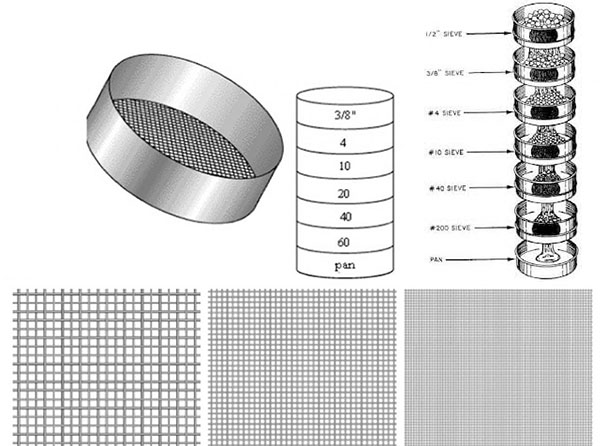
Standard Sand Test Sieve Sizes are 1.4mm, 1.0mm, 0.71mm, 0.5mm, 0.355mm, 0.25mm, 0.18mm, 0.125mm, 0.09mm, 0.063mm and pan.
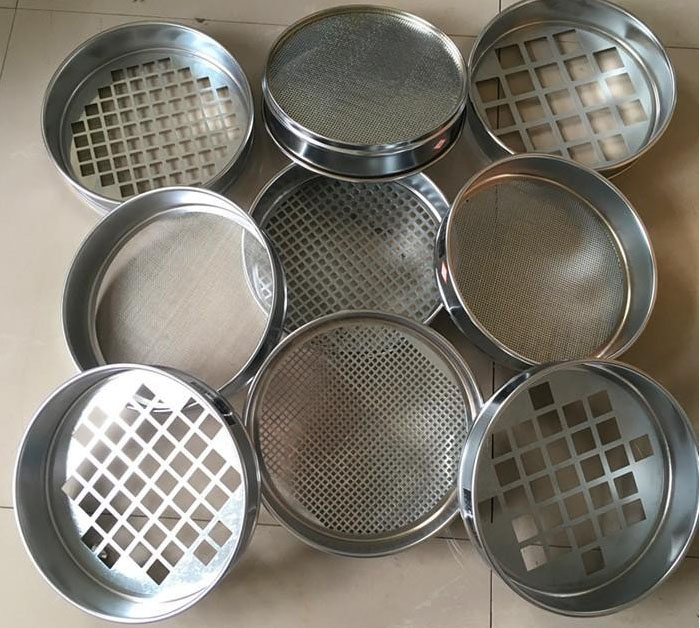
(1) The national standard GB/T14684-2001 stipulates the use of square hole Standard Sand Test Sieve, the hole diameter is 9.50mm, 4.75mm, 2.36mm, 1.18mm, 0.6mm, 0.3mm, 0.15mm;
(2) The standard JGJ52-92 of the Ministry of Construction stipulates that the Standard Sand Test Sieve with round holes of 10mm, 5mm, and 2.5mm and the Standard Sand Test Sieve with square holes of 1.25mm, 0.63mm, and 0.16mm are used;
(3) The standard JTJ058-2000 of the Ministry of Communications stipulates that the Standard Sand Test Sieve specifications for cement concrete are the same as those of the Ministry of Construction; the sand for asphalt pavement is tested by the Standard Sand Test Sieve with square holes, and the hole diameters are: 4.75mm, 2.36mm, 1.18mm, 0.6mm, 0.3mm, 0.15mm, 0.075mm.
Take the required number of sand samples (for sand, a minimum of 0.5 kg sample is required.
Arrange the desired number of sieves from small to large as required. (i.e. keep the sieve with the largest opening at the top and the smallest opening at the bottom)
Screen Arrangement – 10mm on top, 4.75mm, 2.36mm, 1.18mm, 600µ, 300µ, 150µ on bottom and last pan)
Place the sieve group on a mechanical shaker and shake vigorously for at least 2 minutes.
The weight of sand remaining on each sieve is then measured and expressed as a percent pass.
Now compare these values to the recommended values to see if it is within range. If the desired gradation is not achieved, take the necessary steps to give the sand a good gradation.
| Sieve Size | % of Passing | % of Passing | % of Passing | % of Passing |
| Zone – I | Zone - II | Zone -III | Zone – IV | |
| 10 mm | 100 | 100 | 100 | 100 |
| 4.75 mm | 90-100 | 90-100 | 90-100 | 95-100 |
| 2.36 mm | 60-95 | 75-100 | 85-100 | 95-100 |
| 1.18 µ | 30-70 | 55-90 | 75-100 | 90-100 |
| 600 µ | 15-34 | 35-59 | 60-79 | 80-100 |
| 300 µ | 5-20 | 8-30 | 12-40 | 15-50 |
| 150 µ | 0-10 | 0-10 | 0-10 | 0-15 |
Dahan standard sand test sieve factory production, stocking, delivery display.

Screening particle size: 0.025mm-3mm
Price: $538.00 - $925.00/Set
Detection range: 0.075mm-100mm
Price: $20.00 - $200.00/set
Mesh: 10-200 mesh
Price: $18-$300/set
Mesh sizes: 20 microns-5 mm
Price: $656.00 - $975.00/Sets
Standard sand sieve for cement testing
Cement Standard sand sieve is mainly used in various laboratories, laboratories, item screening, sieving, grading and other inspection departments to accurately determine the...
Test Sieve Shaker is an instrument for detecting and analyzing the particle size structure and particle size distribution of 2kg of material in the test sieve. Test Sieve Shaker Pro...
Pharmacopoeial sieves (standard pharmacopoeial sieves) refers to the sieves used for pharmaceutical production according to the national uniform specifications stipulated in the Pha...
Application of wet sieve test screening material
In many cases, wet sieve test sieving, despite the inconveniences that come with it, has clear advantages over dry sieving. For example, the material to be tested may have been susp...
What is the difference between wet sieving and dry sieving
The sieving test is divided into wet sieving test and dry sieving test, so what is the difference between wet sieving and dry sieving? difference Wet sieving test Dry sieving test i...
Are you interested?
![]()
Then we look forward to hearing from you
Contact Us
Industrials
Yanjin county forest park gate to the west 1000 meters north road sitemap
